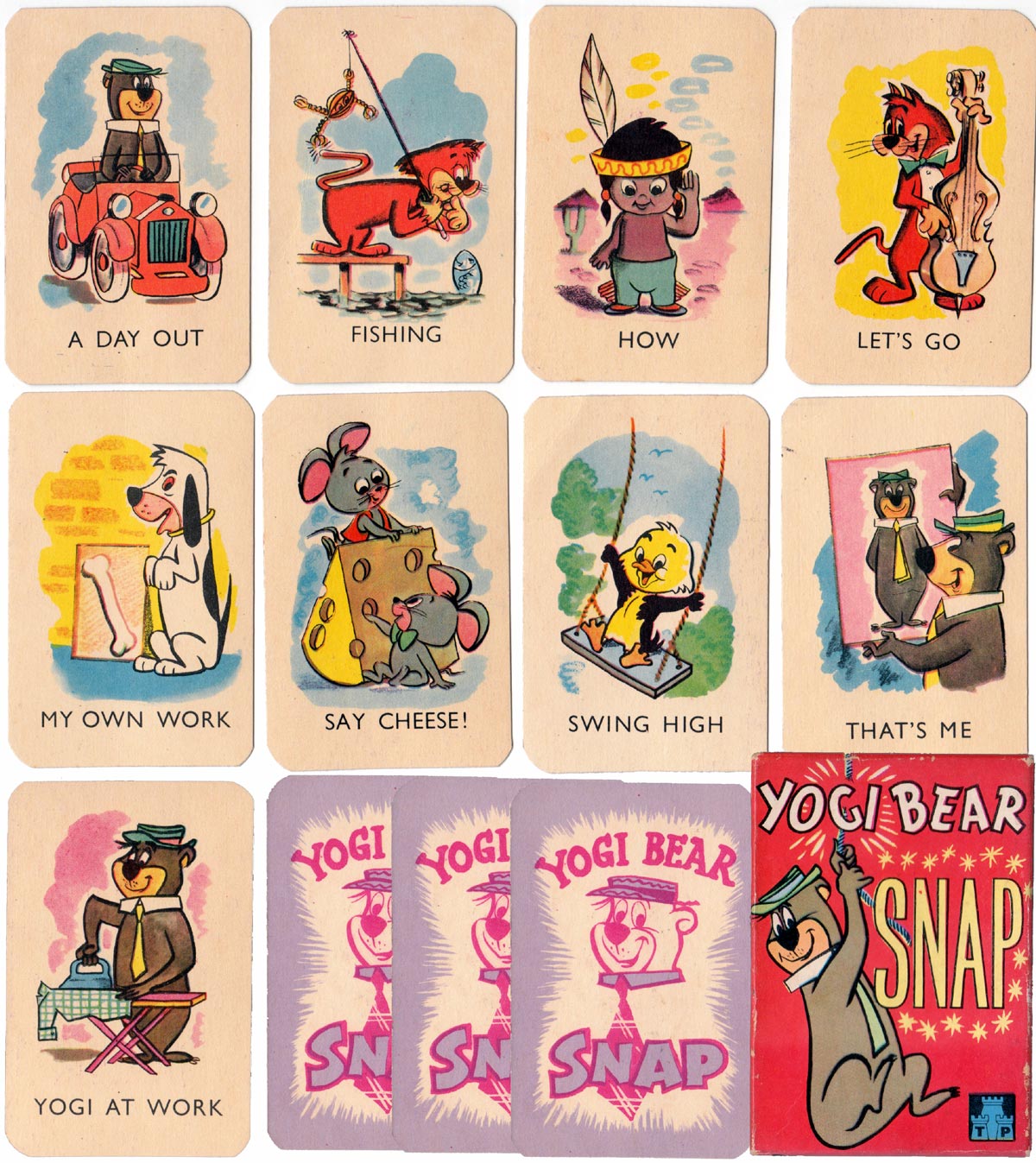Yogi Bear Snap
Yogi Bear Snap No.6647 “Smarter than the average bear” c 1962.
“Smarter than the average bear”
Yogi Bear Snap No.6647, c 1962. Yogi Bear first appeared in “The Huckleberry Hound Show” a cartoon series made for TV by Hanna-Barbera which ran from 1958 to 1962. The show was distributed by Screen Gems part of the TV arm of Colombia Pictures and sponsored by Kelloggs. Yogi was so Popular that he was given his own show from 1960 to 1962 and was replaced on the “Huckleberry Hound Show” by a new character, Hokey Wolf.
Yogi had a companion called Boo Boo, a much younger Bear, and Yogi was always showing off to him by devising new schemes to steal picnic (“Pic-A-Nic”) baskets from the tourists in Jellystone Park where they lived. Sometimes Yogi was thwarted by the park Ranger John Smith, but occasionally he was successful, proving to Boo Boo That he was “smarter than the average bear”

Above: “Yogi Bear Snap” No.6647, c 1962.
Other characters from “the Huckleberry Hound Show” appear on these cards – Mr Jinks (a beatnik cat) and Pixie and Dixie, mice (known as “meeces”) together with at least one from “The Yogi Bear Show”, Yakky Doodle, a miniature duck who was ably protected by Chopper the bulldog who called him his “little fella”. Yogi’s voice was provided by Daws Butler who also voiced Huckleberry Hound, Snagglepuss and Dixie one of the meeces. Much later, in 1988, more programmes were compiled using the stories from the original shows.

By Rex Pitts (1940-2021)
Member since January 30, 2009
Rex's main interest was in card games, because, he said, they were cheap and easy to get hold of in his early days of collecting. He is well known for his extensive knowledge of Pepys games and his book is on the bookshelves of many.
His other interest was non-standard playing cards. He also had collections of sheet music, music CDs, models of London buses, London Transport timetables and maps and other objects that intrigued him.
Rex had a chequered career at school. He was expelled twice, on one occasion for smoking! Despite this he trained as a radio engineer and worked for the BBC in the World Service.
Later he moved into sales and worked for a firm that made all kinds of packaging, a job he enjoyed until his retirement. He became an expert on boxes and would always investigate those that held his cards. He could always recognize a box made for Pepys, which were the same as those of Alf Cooke’s Universal Playing Card Company, who printed the card games. This interest changed into an ability to make and mend boxes, which he did with great dexterity. He loved this kind of handicraft work.
His dexterity of hand and eye soon led to his making card games of his own design. He spent hours and hours carefully cutting them out and colouring them by hand.
Related Articles

Tangle Foot Ale
Badger Brewery Tangle Foot strong ale advertising pack.

Scientific Whist
“Scientific Whist” : standard cards with instructions for play on the faces by Chas Goodall & Son, 1...

Agent Provocateur
Branded lingerie collection in a pack of pin-up playing cards.

Nimbus playing cards
Mike Steer’s weather-themed pack with suits in four colours and backs for cardistry.

Agatha Christie and Playing Cards revisited
Agatha Christie uses card-play as a primary focus of a story, and as a way of creating plots and mot...

The Decadent Deck
Studies in the eroticism of the female body by Inge Clayton.

Historic Shakespeare
“Historic Shakespeare” playing cards featuring Shakespearean characters by Chas Goodall & Son.

Copechat Paramount Sorting System
Preserving the past: a specimen deck showcasing edge-notched cards and their ingenious sorting syste...

Heartsette by Herbert Fitch & Co, 1893
A glimpse into a busy print and design office in late Victorian London.

Rap Rummy
Rap Rummy made by Parker Brothers in 1926, only 4 years after the discovery of King Tutankhamen’s to...

Batman® playing cards
Batman playing cards published by InterCol of London 1989.

Can You Believe Your Eyes?
“Can You Believe Your Eyes?” playing cards featuring visual illusions & other oddities.

Pastime Playing Cards for the Blind
The “Pastime” Playing Cards for the Blind manufactured by Goodall & Son Limd., c.1910.

The European Interchanges Quartets
A card game based around motorway intersections from European countries.

Songs with Flute accompaniment
Eighteenth century English engraved cards with music for voice and flute.

Love Tests
Vintage novelty “Love Test” cards of a slightly saucy nature but all in good fun!
Most Popular
Our top articles from the past 28 days

